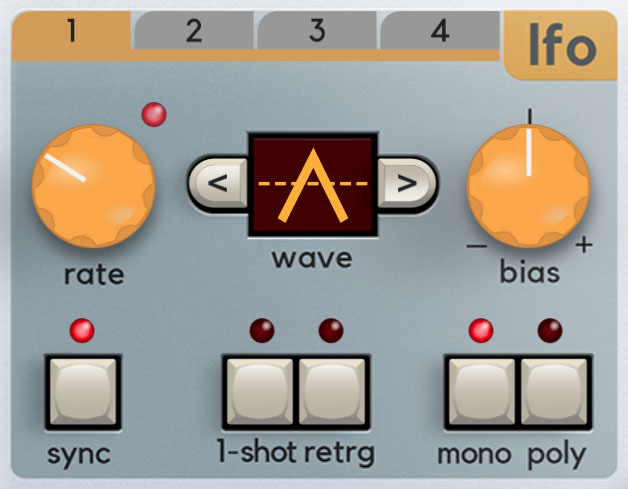
LFO is short for "low-frequency oscillator." Harmonia's four onboard LFOs generate sub-audio range signals for modulation purposes. Each LFO is functionally identical and independent. To set and LFO's parameters, select the one you'd like to edit by clicking on one of the four numbered tabs along the top.
Rate knob and Sync button- The Rate knob defines the speed of the LFO, from 0.01 to 30 Hz (with Sync switch off) or from 8 beats up to 1/64th note triplets (Sync button enabled). The Sync button locks the LFO to host tempo when using Harmonia within DAW software, or to the current tempo in the top menu bar when using the standalone version. The LED above the Rate knob flashes at the current modulation rate.
Wave- Click the window to select a modulation waveform, or click on the arrow buttons on either side of the display to cycle through them. The mod waves include sine, triangle, ramp, exponential ramp, logarithmic ramp, saw, exponential saw, logarithmic ramp, square, or sample and hold (i.e. stepped random).
1-Shot- LFOs typically are cycling constantly (that whole "oscillation" thing), but the engaging the One Shot button causes the LFO to move through its cycle a single time when a key is struck. For all intents and purposes, this converts the LFO to a simple envelope generator. This is especially useful when the saw and ramp waves are used to modulate the oscillator Center and Width controls.
Note that the Rate control defines the duration of the single LFO "envelope" cycle (lower setting = longer time), and also that the Sync button still works, which is useful for rhythmically locked envelopes.
Because One Shot mode uses a section of a wave that normally be endlessly repeating, and in order for them to be most useful, the individual waves have slightly varying behaviors. We'll do our best to explain how each of them function when in One Shot mode, with Bias set to Bipolar.
Sine- CV begins at 0V, up to 5V, falls to -5V, returns to 0V and holds.
Triangle- CV begins at -5V, up to 5V, falls to -5V and holds.
Ramp/Expo Ramp/Log Ramp- CV begins at -5V, rises to +5V and holds.
Saw/Expo Saw/Log Saw- CV begins at +5V, falls to -5V and holds.
Square- CV begins at +5V, instantaneously falls to -5V and holds.
Sample and Hold- CV beings at a random voltage and holds until note retrigger.
Bias- Bias defines the range of the LFO wave's swing. As the knob is turned, the dashed line in wave display moves to clarify the LFO range.
At center position, the voltage swings up and down equally. If the knob is turned all the way to the right, the CV swings from 0V to +5V back to 0V. If the knob is turned all the way to the left, the CV swings from -5V through 0V to +5V back through 0V to -5V, etc. The effect of LFO bias differs depending on mod depth and inversion settings (i.e. negative amounts of mod), as well as the parameter the LFO is modulating.
Retrigger (Retrg)- Defines LFO restart behavior when keys are struck.
In normal cycling mode (1-Shot disabled), enabling Retrg restarts the LFO cycle monophonically, that is, if no notes are currently on and a new note is struck, the LFO cycle restarts. If additional keys are played, the LFO won't restart until all keys are released. This may seem counterintuitive, but it makes sense - imagine a polyphonic patch with square wave modulation applied to oscillator amplitude (i.e. OSC Level knob mod). If you played a chord, with each note struck at a (slightly) different time, the "on/off" mod of each note would be occurring at a different time, resulting in a sloppy-sounding mess. Having the modulation "synchronize" in this way generally has much more musical results.
Conversely, if both 1-Shot and Retrigger are enabled, the LFO sweep restarts with every note played, regardless of previously held notes. This makes sense if you're using 1-Shot LFOs in the role of envelope generators controlling the oscillator Center or Width controls, filter cutoff frequency, etc.
Mono/Poly- This sets whether the LFO operates globally for all voices, or each voice has its own independent LFO. Mono operation is generally most desirable when the LFO is being used for standard pitch modulation (vibrato) or filter wah-wah effects. Mono LFO mod is also desirable if you're modulating the oscillator Center or Width controls, and you'd like all notes to receive the same modulation.
Poly LFO modulation is most useful when the LFO is 1-Shot mode and being utilized like an envelope generator - for example, the LFO is being used to modulate the oscillator Center control, and you'd like each note played to swoop through its harmonics independently. This is similar to using the filter or amp envelope for the same purpose, but by using an LFO in 1-Shot mode, you won't need to "waste" an envelope generator that you might want use elsewhere.